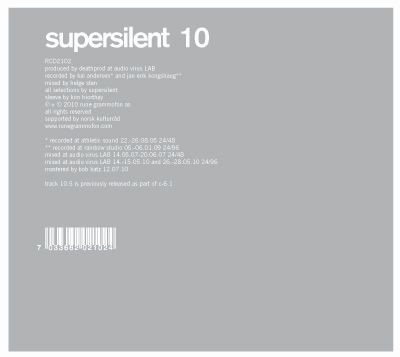
Supersilent
10
(Rune Grammofon; 2010)
By Joel Elliott | 2 December 2010
Finally, Supersilent are human. If on 8 (2007) they were gods out of a Wagner opera and on 9 (2009) they were half-awake automatons, for 10 all three members seem happy in their individual corners. Not that there aren’t still moments of synergy, but that for the first time perhaps, the music can be talked about in concrete terms: there’s a grand piano, breathy trumpet, and that thing that Deathprod does that may have become the most comforting sound ever to evoke the deepest chasm of existential dread. The world of obscuro music crit breathes a collective sigh of relief. Finally, this band sounds like someone else’s pain and not my own.
Sadly, it might also be proof that Supersilent will never fully get over the loss of drummer Jarle Vespestad. The band never adhered to rhythm so much as the suggestion of rhythm, and yet the idea that they were working out some unnamed problem in real time always seemed to be the source of exhilarating. Their first 8 albums (and really, there’s hardly a dull note in any of them) transcended their improvised origins by the combination of restraint and intensity through which all four members fed off each other and worked out every idea to its logical (or illogical) conclusion. In a strange paradox, 10 sounds both rougher and more composed, as if it were assembled in separate rooms.
Perhaps all these contradictions of presence/absence or foresight/spontaneity are interesting in and of themselves, but when you can nail down the core of a track through which all the other elements are built up, a lot of the mystery that sustains this band fades. “10.3” is built around a grand piano that moves around in negative space in a way which might have something to do with some kind of Cage-esque aleatoric fugue but really sounds more like what someone who spent their entire life listening to a performance of Erik Satie’s Vexations might describe as “jazz.” It’s not fun, and only slightly redeemed by Henriksen’s horn, which seems to just lament the whole ennui of the affair. “10.11”’s evocation of a distant, lonely sonar operator is fascinating, but is it more interesting to listen to or write about? Perhaps if some of these tracks were fleshed out a bit more they might actually get to the bottom of whatever it is they’re looking for.
Incidentally, the best tracks are the most conventional. Ironically, post-drummer, Supersilent find their most metered track to date in “10.6,” built around measured guitar tones where the trumpet and piano gently fill the down-beat in what is an honest-to-goodness state of bliss uncomplicated by the menace that seems to always creep their work. Seriously, you could do yoga to this shit. Which obviously brings to mind Henriksen’s more worldly (I’m not going to say more “new age-y” or “world music-y” for the benefit of the doubt) solo work, but with the kind of discipline and focus that only Ståle Storløkken and Deathprod bring to the table.
It’s “10.8” that suggests, however, that this band really has a future as a trio. Floating around the simplest guitar progression imaginable, it might be, without exaggeration, one of the most weightless pieces of music ever recorded. Here Henriksen’s strategy to evoke the feeling of a Japanese flute through the full-bodied tone of a trumpet seems to have reached its full fruition, and every sound behind him seems to rise and fall as if it were only sustained by his playing. I was working with some NASA footage for a documentary and I instantly gravitated towards this track to back it up. It’s almost too easy: it evokes the lethargic pace and polarity of darkness and light too well on its own. It’s hardly favorable to the mass of conflicting forces that left me dizzyingly self-aware three years ago, but hey, everyone has to move on.





